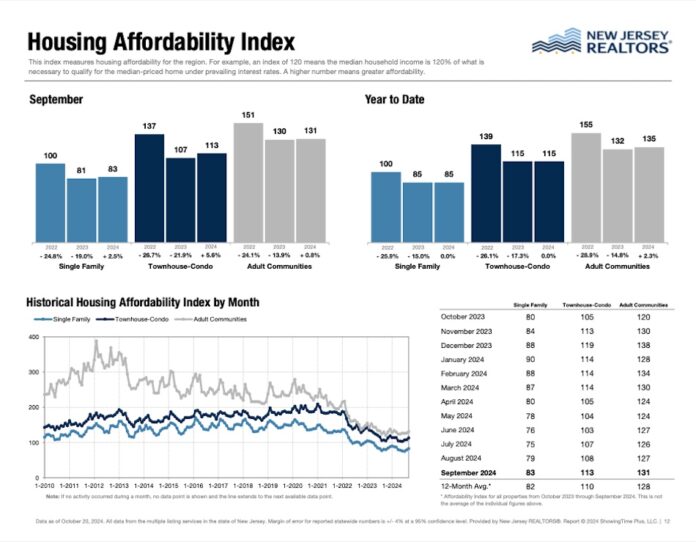Is New Jersey’s Approach to Housing Affordability on the Right Track?
In New Jersey, the struggle for affordable housing is intensifying, with many residents caught in the vice of high living costs and limited financial resources. Despite the state’s efforts to introduce relief measures, such as a newly launched tax assistance program, a significant portion of the population remains excluded. The key question is: Are these initiatives effectively addressing the state’s housing affordability challenges, or are they merely scratching the surface?
The Growing Housing Affordability Crisis in New Jersey
New Jersey’s housing market has long been a difficult terrain for residents, especially those with lower incomes. With soaring property taxes, a lack of affordable rental units, and housing prices that consistently exceed national averages, many New Jerseyans find themselves grappling with financial hardship. According to U.S. Census Bureau data, the median home price in New Jersey is well above the national figure, and even in mid-sized cities like Trenton and Newark, rents have surged, making basic living expenses increasingly difficult to manage.
This dynamic has resulted in a high percentage of residents spending a disproportionate amount of their income on housing. For many, the consequences of these inflated housing costs extend far beyond rent—they are forced to cut back on essentials like healthcare, education, and even food. As a result, addressing this crisis has become a top priority for both state officials and advocacy groups.
New Jersey’s Latest Tax Relief Program: A Step Forward?
In an attempt to alleviate the growing burden of housing costs, New Jersey introduced a state-backed tax relief program aimed at providing financial assistance to renters and homeowners alike. This initiative is designed to offer tax credits to households that are overburdened by their housing expenses, specifically targeting those who are spending more than 30% of their income on housing—a common benchmark for determining housing affordability.
At first glance, the program seems promising, offering much-needed relief for many residents who are teetering on the edge of financial instability. By funneling funds directly to individuals in need, the tax credits are intended to reduce the impact of rising property taxes and rents. For those who qualify, this program could provide vital financial breathing room.
The Drawbacks: Who’s Left Behind?
While well-intentioned, New Jersey’s tax relief initiative has not been as inclusive as its supporters had hoped. Many residents who need this relief the most are being left out due to the program’s restrictive eligibility criteria. A significant number of low-income renters, for example, do not meet the program’s requirements because they don’t own homes or don’t meet the state’s other guidelines. This leaves out a large swath of renters, especially those in more transient or lower-income communities, who are often the hardest hit by rising costs.
Moreover, the relief offered through these tax credits is often too minimal to provide lasting relief. While the credits may ease the financial burden for some households, they are not sufficient to offset the rapidly increasing costs of living, particularly in areas with high demand. For many residents, even with the tax relief, housing remains unaffordable, and the program falls short of being a comprehensive solution to the broader issue.
The Root Causes of Housing Affordability: Supply and Demand Imbalance
At the heart of New Jersey’s housing crisis is a fundamental issue: there simply aren’t enough affordable homes to meet the demand. The state is densely populated, and there is limited space to build new homes, particularly in high-demand urban areas. Zoning restrictions and local opposition to affordable housing projects further exacerbate the problem, particularly in wealthier municipalities. Meanwhile, luxury housing developments continue to sprout up in cities like Hoboken and Jersey City, while affordable options remain scarce.
The lack of affordable housing units is exacerbated by the state’s aging housing stock. Many of the homes that could serve lower-income residents are in need of costly repairs, but developers are often reluctant to invest in renovating these properties when they can instead build new, more profitable luxury units. This chronic underdevelopment of affordable housing exacerbates the imbalance between supply and demand, leaving many families without affordable options.
While tax relief programs may provide temporary help, they don’t address the root causes of the affordability crisis. By focusing primarily on direct financial assistance without addressing the structural issues of housing supply, the state’s approach risks offering a short-term fix instead of a long-term solution.
Solutions Beyond Tax Relief: Expanding Housing Options
Affordable housing advocates argue that New Jersey’s current policy approach, while beneficial for some, falls short of addressing the root causes of the affordability crisis. In their view, the state needs to place greater emphasis on expanding the supply of affordable housing. This could involve revising zoning laws to allow for the development of more affordable units in urban centers and suburbs alike. These changes could encourage private developers to build more affordable housing, ultimately leading to a broader range of options for residents at different income levels.
One of the most talked-about solutions is inclusionary zoning, a policy that requires developers to set aside a portion of new housing units for low- and moderate-income residents. While inclusionary zoning has seen success in other parts of the country, it remains a contentious issue in New Jersey, where developers and certain municipalities often resist such policies due to concerns about reduced profits and community opposition.
Expanding housing voucher programs is another potential solution. These programs, which provide rental assistance to low-income households, have the potential to help renters afford higher rents. However, critics point out that these programs are often underfunded, leaving many who need assistance unable to access it. To make a meaningful impact, the state would need to significantly increase funding and ensure that more residents can benefit from these programs.
Public-Private Collaboration: A Path Forward?
A growing number of housing experts suggest that greater collaboration between the public and private sectors could help bridge the affordability gap. This might include offering developers tax incentives or grants to build affordable units. However, the challenge lies in ensuring that these incentives actually translate into affordable housing opportunities, rather than simply enriching developers at the expense of low-income residents.
While these public-private partnerships could be an effective means of generating affordable housing, they must be carefully managed to ensure that the needs of residents are prioritized. Otherwise, they risk further entrenching the inequality that currently characterizes New Jersey’s housing market.
A Mixed Picture for Housing Relief
In sum, New Jersey’s efforts to address housing affordability through programs like the new tax relief initiative represent an important step forward, but they don’t go far enough. The lack of affordable housing units, rising property taxes, and stringent eligibility criteria leave many residents without access to the relief they need. To truly tackle the state’s housing crisis, New Jersey must look beyond short-term financial assistance and invest in long-term solutions that expand the availability of affordable housing.
While programs like tax credits are useful for providing temporary relief, they fail to address the fundamental issue of housing scarcity. To create a more affordable and sustainable housing market, New Jersey needs to invest in new housing development, reform zoning laws, and increase funding for housing assistance programs. Only by confronting the root causes of the affordability crisis will the state be able to offer meaningful relief to all of its residents.
For now, New Jersey’s housing crisis remains a challenge, with no quick or easy solutions in sight. The state’s current strategy provides some help, but it lacks the comprehensive vision needed to solve the deep-rooted issues that continue to trap many families in a cycle of unaffordable housing. Time will tell if New Jersey can pivot toward a more holistic approach that truly addresses the needs of its residents.











